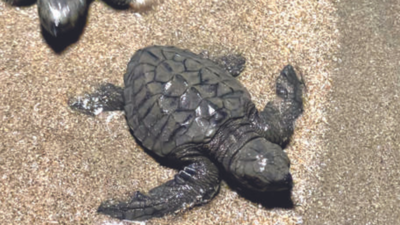Top Searches
Olive Ridley nests cross 100, a record despite partying blitz

In the Morjim-Mandrem belt, the 2021-22 season with 52 nests, including 42 in Morjim itself, was perhaps the best in recent years
PANAJI: Braving hostile conditions of harsh lights, brash music and disturbing footfall at some nesting sites, Olive Ridley turtles seem to be hotfooting their way to a record this season. The number of nests has crossed the century mark.
On the weekend, one more turtle arrived at Morjim, taking the tally of nests scooped up by the flippered visitors for laying eggs in North Goa to 55, as compared to 57 in South Goa. Morjim and Mandrem in Pernem taluka and Agonda and Galgibaga in Canacona are the four officially designated turtle nesting sites in the state.
For South Goa, 44 pits at the teeming, world-famous Agonda beach and 13 at the less frequented Galgibaga beach are records. The previous tally of the highest number of nests was recorded not long ago, in 2020-21, when the forest department had registered 39 -28 in Agonda and 11 in Galgibaga.
In the Morjim-Mandrem belt, the 2021-22 season with 52 nests, including 42 in Morjim itself, was perhaps the best in recent years. The nesting continues, as turtles arrive even in May due to climate change dynamics.
"The number of nests recorded, both in North and South Goa, itself is a record," said Sujeetkumar Dongre, programme coordinator, Centre For Environmental Education (CEE), Goa. "This is perhaps because of identification, recording and monitoring of nests all over the coast by both citizens and the forest department."
About 9,000 eggs have been laid at the sites, including from relocated nests, and the hatching process has started. With a naturally isolated stretch, Mandrem is turning out to be good nesting ground. "Three days ago, a mother nested while hatchlings emerged almost simultaneously," a source said.
The modest turtle conservation programme pioneered on Morjim beach in the 1990s has grown significantly, despite stressors of tourism activity and other factors such as severe beach erosion. A Catholic priest, Fr Mariano Proenca, supported the replication of the initiative on the quiet Galgibaga beach.
Olive Ridley turtles nesting in thousands on the Odisha coast are known to return to their place of birth for nesting. In Goa, they used the entire coast for breeding before tourism arrived, but poaching of eggs and destruction of nests by stray animals was a major threat for years. Now, even fishermen and others, in places like Cavelossim, help in turtle conservation.
The lack of multilingual signage to create awareness about turtle nesting, and intrusion in turtle sanctuary areas by tourists and vehicles are some stressors for the turtles.
Forest officials see positives in their minister showing interest in turtle conservation. "The department will start an information centre, install signages and work on other infrastructure shortly at the nesting sites," an official said.
On the weekend, one more turtle arrived at Morjim, taking the tally of nests scooped up by the flippered visitors for laying eggs in North Goa to 55, as compared to 57 in South Goa. Morjim and Mandrem in Pernem taluka and Agonda and Galgibaga in Canacona are the four officially designated turtle nesting sites in the state.
For South Goa, 44 pits at the teeming, world-famous Agonda beach and 13 at the less frequented Galgibaga beach are records. The previous tally of the highest number of nests was recorded not long ago, in 2020-21, when the forest department had registered 39 -28 in Agonda and 11 in Galgibaga.
In the Morjim-Mandrem belt, the 2021-22 season with 52 nests, including 42 in Morjim itself, was perhaps the best in recent years. The nesting continues, as turtles arrive even in May due to climate change dynamics.
"The number of nests recorded, both in North and South Goa, itself is a record," said Sujeetkumar Dongre, programme coordinator, Centre For Environmental Education (CEE), Goa. "This is perhaps because of identification, recording and monitoring of nests all over the coast by both citizens and the forest department."
About 9,000 eggs have been laid at the sites, including from relocated nests, and the hatching process has started. With a naturally isolated stretch, Mandrem is turning out to be good nesting ground. "Three days ago, a mother nested while hatchlings emerged almost simultaneously," a source said.
The modest turtle conservation programme pioneered on Morjim beach in the 1990s has grown significantly, despite stressors of tourism activity and other factors such as severe beach erosion. A Catholic priest, Fr Mariano Proenca, supported the replication of the initiative on the quiet Galgibaga beach.
Olive Ridley turtles nesting in thousands on the Odisha coast are known to return to their place of birth for nesting. In Goa, they used the entire coast for breeding before tourism arrived, but poaching of eggs and destruction of nests by stray animals was a major threat for years. Now, even fishermen and others, in places like Cavelossim, help in turtle conservation.
The lack of multilingual signage to create awareness about turtle nesting, and intrusion in turtle sanctuary areas by tourists and vehicles are some stressors for the turtles.
Forest officials see positives in their minister showing interest in turtle conservation. "The department will start an information centre, install signages and work on other infrastructure shortly at the nesting sites," an official said.

About the Author
Paul FernandesPaul Fernandes, assistant editor (environment) at The Times of India, Goa, has more than two decades of experience behind him. He writes on social, environmental, heritage, archaeological and other issues. His hobbies are music, trekking, adventure and sports, especially football.
Start a Conversation
FOLLOW US ON SOCIAL MEDIA
FacebookTwitterInstagramKOO APPYOUTUBE









